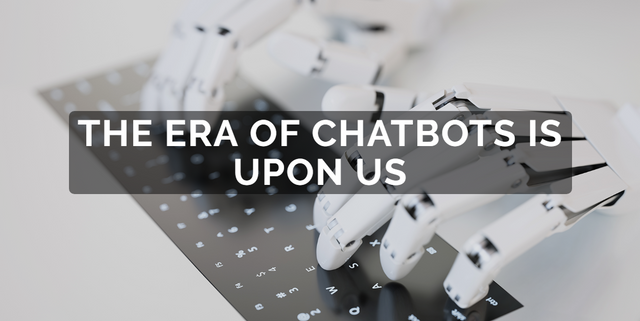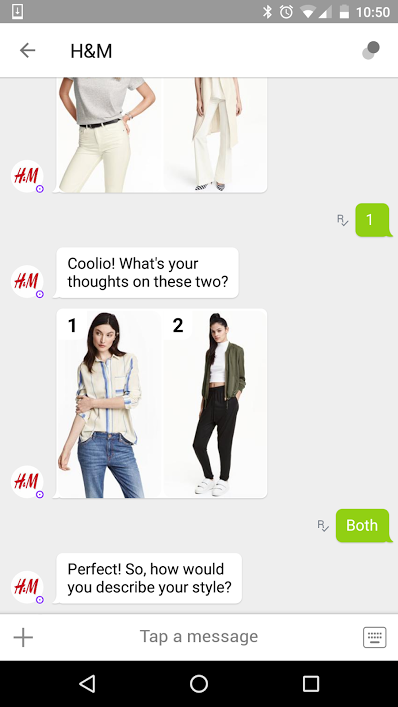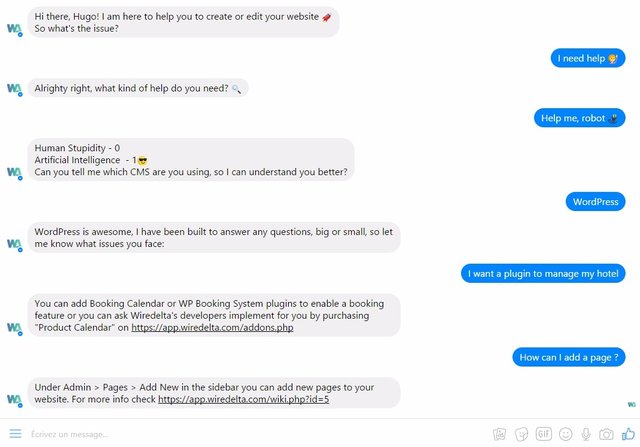The Era of Chatbots is Upon Us

In April 2017, we learned that no less than 100,000 chatbots were created for Facebook Messenger alone in the past twelve months. So believe it or not, there is a bot-mania going on out there. But what are they? And why are they the new fashionable tech thing right now?
Basically, chatbots are programs created in order to simulate conversations with human users. That definition gives us the first hint in regards to their huge potential. If a chatbot is smart enough, it would be able to:
- Deal with common and easy queries that users have.
- Answer an unlimited number of questions at the same time.
No wonder then why 80% of brands are keen on implementing a bot by 2020. Chatbots are likely to help businesses to save huge amounts of time in their processes by handling basic interaction tasks. In addition, they will allow staff to focus much more on the most challenging missions.
So let’s face it: it looks as if bots are here to stay. Though bots’ theoretical potential is massive, this does not mean that it will be an easy task for organizations to leverage this trend. In order to keep up with users’ expectations, developing a chatbot is always an on-going task. Not to forget that making a program appear as human as possible can sometimes seem close to mission impossible. Think of humor, irony, context understanding and so on, but for a machine!
But will these challenges slow down the trend? We don’t think so. As we will be seeing it at first, progress in artificial intelligence has been exponential in the past decades. And as a matter of fact, businesses in every industry are now going crazy about it. Unstoppable?
A Glimpse at the Chatbot History
Eliza, the very first Chatbot was developed back in the 60’s. An MIT professor set a program that could interact with people like a psychotherapist would. Looks pretty ambitious and sophisticated for that period of time, right? But here’s the trick, Eliza was basically repeating what its conversation partner was saying by rephrasing the content as a question:
As a matter of fact, poor Eliza had no clue about the context and no understanding of the content. But thanks to a smart pattern and keyword programming, the conversation looked realistic. After all, isn’t the role of a psychotherapist to ask questions? Ironically, despite how superficial the interaction was, some users of the program connected with Eliza. And they started to develop an emotional bond with “her”.
Eliza paved the way for a long line of chatbots among which we can point out:
- A.L.I.C.E (1995) – or Artificial Linguistic Internet Computer Entity, which won the Loebner Prize several times. This prize is awarded to the most human-like chatbots, based on the Turing Test. The latter consists of a player chatting, via text messages, with two other players. The purpose of the test is to figure out who among these two players is human and who is not.
- Jabberwacky (1997) which aimed to “simulate natural human chat in an interesting, entertaining and humorous manner” following his creator Rollo Carpenter. So if you are a fan of nonsense conversations, you will definitely appreciate witnessing this one:
Unlike the majority of chatbots, Jabberwacky actually learns from its previous dialogs in order to grow its knowledge and therefore the variety of its answers.
- SmarterChild (2001) which was the first widespread consumer chatterbot (30 million users!). Available on MSN, it reached high levels of relevance and therefore humanity that was unbeaten so far. However, how hard you would try to disconcert SmarterChild (swearing, making a pass at it), it always seemed to know how to respond. Nevertheless, SmarterChild was not as smart as its name suggests it. Indeed, its “intelligence” relied more on huge data collection than on independent machine learning algorithm (cf. Jabberwacky). Developers had to constantly add new intents to Smarterchild to allow it to face any kind of query.
As time passed, new and more powerful chatbots relying on artificial intelligence emerged. Apple’s Siri (2011) is a personal assistant that can make web searches, write text messages, set a timer etc. Followed later Google Now (2012) created by Google (yes, absolutely), Amazon’s Alexa (2015) and Microsoft’s Cortana (2015). This trend illustrates how useful and popular virtual assistants are starting to become in our everyday lives. The following video made by Mark Zuckerberg, in which a Jarvis-like house assistant is staging, isn’t really a SciFi despite its promotional aspect.
And more features such as facial expression reading, making it possible to adapt to your mood, are to come!
Why are Chatbots so Attractive to Businesses?
In the past years, chatbots became way easier to develop. And as such, they are drawing the considerable attention of business owners. Oracle surveyed 800 decision makers (including Marketing Managers, Chief Strategy Officers, and Sales Executives) across France, the Netherlands, South Africa, and the UK. 36% of them declared that they were already using chatbots while 44% are eager to implement them by 2020. Why so?

Image Source
Only 20% of the surveyed decision makers do not plan to implement chatbots in their businesses.
A Great Tool for Customer Service
– Where is your main store located?
– Can I return an article 2 months after I bought it?
– Is this video game only available in English?
Any customer service staff would have the ability to answer these easy questions. But why bother when a bot can be programmed to answer these basic queries? Not to forget that such an employee is not without advantages as compared to its human colleagues.
- Convenience: The bot would be accessible through a messaging platform (such as Facebook Messenger) or on the company’s website.
- Instantaneity: It will answer in a matter of seconds.
- Availability: A virtual assistant neither sleeps, eats or takes a break.
In point of fact, these features are a must. A glance at a survey made by Ubisend makes it very clear. Among the 2000 persons asked in the UK, 51% declare that a business needs to be available 24/7. Also, 69% of them mention they would rather contact a company through a chatbot to be answered instantaneously.
And if ever chatbots run out of responses, they will still redirect users to customer service representatives. This upstream filtering unclogs customer support departments that will be able to focus on people that need more specific help. Thus, human staff gets rid of dull and time-consuming tasks (customer’s profiling, document collection, frequently asked questions, etc.). According to Gartner, thanks to the use of chatbots, only a third of all customer service interactions will require the support of a human by the end of 2017. As a consequence, employees will have more time to focus on more complex and interesting missions.
A Way to Boost Marketing & Sales
Sales-wise, making orders through chatbots is getting increasingly common. DigitasLBi found out that even though only 1 American out of 5 have heard of them, 37% of the respondents stated that they would be willing to place orders with chatbots.
Thus, some companies started developing virtual assistants of their own in order to process orders. Last year Pizza Hut introduced a chatbot allowing customers to order food via Twitter and Facebook. In addition, it is also able to answer to frequently asked questions and inform customers about current Pizza Hut’s promotions.

Image Source
Pizza Hut made it possible to place an order via a chatbot.
But that’s not all, more than a half of Americans are willing to contact companies via chatbot to receive:
In order to respond to these trends, H&M has developed a chatbot which is able to suggest you various outfits based on your gender, age, and style. If you like an outfit, the bot will redirect you to H&M’s website so you can place an order. If you don’t like an outfit, it will display a new one…and learn a bit more about your tastes at the same time.

Image Source
H&M chatbot helps you select and buy outfits according to your tastes.
From a marketing perspective, chatbots appear as the next step after social media to engage with consumers. Talking to a company through an instant messenger app can turn out to be more interactive than watching a video. Or reading a blog post. Indeed, it feels as you are truly interacting with a person. Chatbots help to reach a new level of socialization and personalized relationship with customers.
Hence, to promote the movie Zootopia, Disney created a Judy Hopps (the main character) bot. Chatting with the rabbit officer on Facebook Messenger allowed users to solve mysteries and therefore enabled the entertainment corporation to go further in terms of storytelling. Eventually, the stemming sympathy would encourage users to watch the movie.

Image Source
Disney created Judy Hopps chatbot to sympathize with the fans…or future fans.
A Cost-Saving Technology
Lastly, using chatbots also happen to be a step forward in order to reduce costs in various business areas. According to McKinsey, the costs of customer service labor amount to $79 billion in the US. The use of chatbots could allow companies to reduce this amount by 23 billion which is equivalent to a 29% decrease. The same applies to sales where salesforce costs could be reduced by $15 billion, according to the same studies.
Even though chatbot implementation is a global trend, some industries, in particular, are at the forefront. For instance, bank and insurance companies are creating bots having access to customers’ data. Bank statement, cash flows, age and so on. That will allow them to offer personalized financial services and insurance policies thanks to artificial intelligence and predictive analysis. Close to the half of annual expenditures in salaries for sales representatives could hence be saved!
The Coming Challenges
Despite their growing relevance and their huge potential value for both business and consumers, chatbots are to face a few obstacles.
The First Impression is Key
People judge the book by its cover. As such, there is no second chance to make a good first impression. It only takes a few seconds for a user to assess the design of a website and decide whether to stay or not. The same rule applies to chatbots. Therefore, not being able to handle a conversation properly can be fatal. A dumb chatterbot will irritate users more than anything. It is crucial for the software to:
- Anticipate a maximum of the users’ questions. Conduct the conversation flow into a direction in which it can provide guidance.
- Recognize when it is unable to answer the customer. It can then pass on the conversation to the human support team.
- Be immunized against any bad influence if based on a “learning by chatting” principle.
Last year Microsoft released a bot name TAY (Thinking About You) via Twitter. The AI was supposed to mimic a female teenager getting smarter as you talked to “her”. Unfortunately, after receiving tons of racist and misogynistic tweets, TAY became out of control. She started releasing insults and offensive messages on Twitter. 16 hours later, Microsoft had no choice but to suspend her. Not the kind of bot you want to have for your business.

Image Source
After a few hours, TAY became totally out of control.
The Privacy Concerns
Some chatbots are supposed to “remember” answers from previous conversations. Companies can then make more targeted offers. As a matter of fact, every technology collecting data about consumers legitimately raises some concerns. In the US, nearly a third of American households find it invasive that chatbots store data about past conversations, purchase history and personal preference. For this reason, it is essential for businesses to demonstrate total transparency in regards to the data they may be using.
Messenger apps – The Privileged Gateway for Chatbots
A Gateway to Millions of Users
In April 2016, Facebook announced they were releasing an API that would enable developers to create chatbots able to communicate with users on Messenger. Other companies, such as Kik, Slack, Telegram, and Slack are now also allowing bots on their platforms.
What is at stake is huge. Messenger, for instance, probably the most popular platform for bots, grants access to more than 1.2 billion Facebook users. While other messaging applications still give access to hundreds of millions of them.
Becoming a daily partner
Chatbots on messaging platforms can perform a wide range of tasks such as giving you the weather forecast, reading the news you are interested in, etc.
Earlier this year, Facebook also enabled bots in group conversations. Chatbots now have to face extra complexity as they have to interact with several conversation partners at the same time. However, thanks to this innovation, groups of friends can build a Spotify playlist, book a hotel or even plan their holidays trip together.
Our Chatbot is on Facebook Messenger too!
At Wiredelta, we are also developing a chatbot of our own. For all CMS users keen on WordPress, Drupal and Magento, our bot is there help you create, design and customize your website or app. The end goal of our chatbot is to allow the average non-technical people to create their own website. You can chat with our bot on Messenger.

Image Source
Any query related to CMS website building? Go on and try our bot.
Conclusion
Chatbots are starting to handle a great number of basic tasks. Meanwhile, humans will be able to dedicate full attention on more specific and complex cases that require creativity and innovative ideas. All in all to provide better customer service, increase customer satisfaction and reduce cost.
But are chatbots 100% beneficial? One of the major concerns as of today is about job losses due to automation. Even though some jobs will probably not be replaced, we believe that overall, new ones, more interesting and requiring advanced qualifications as well as human touch, will emerge. But this topic for sure deserves another article 😉